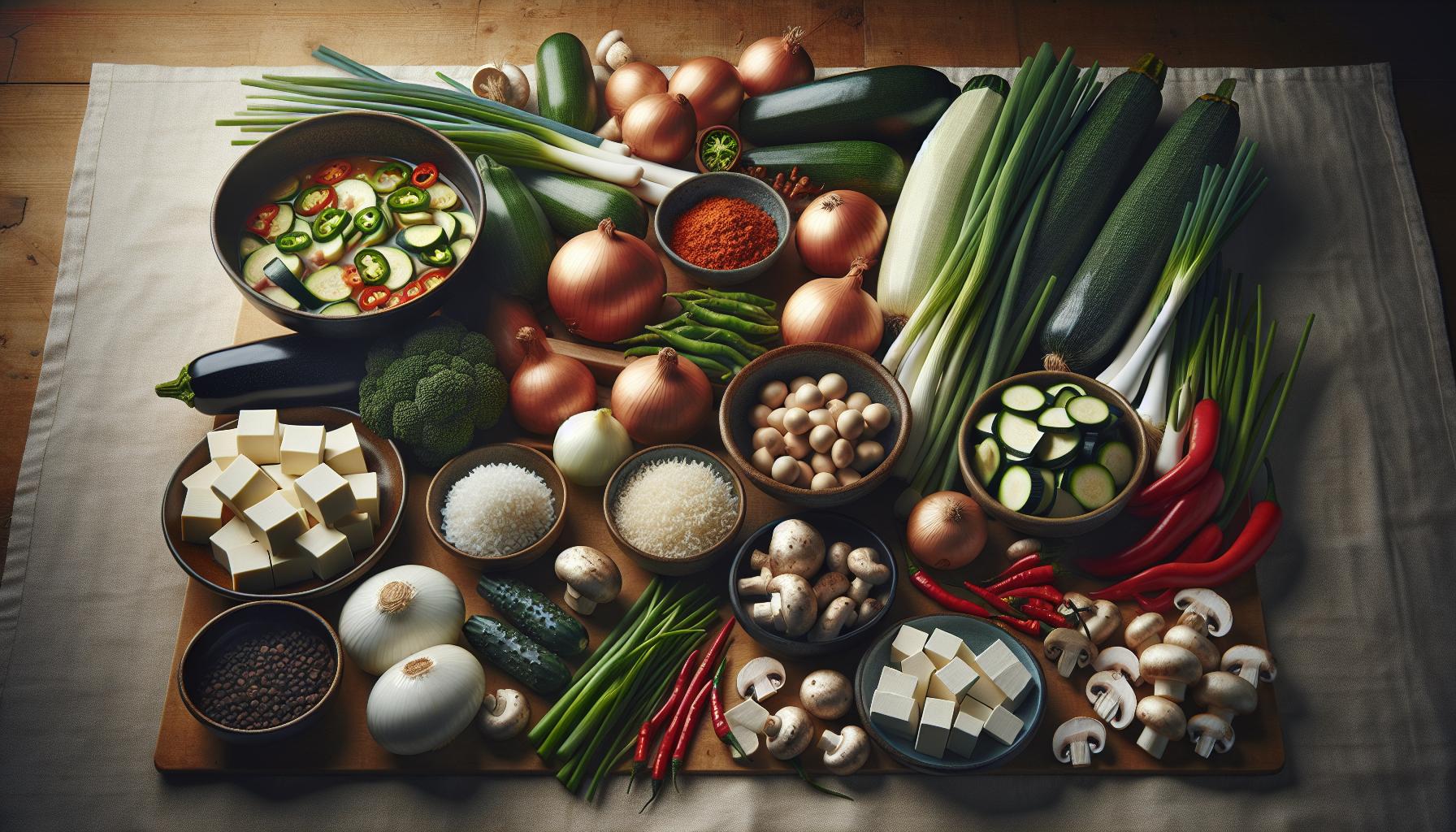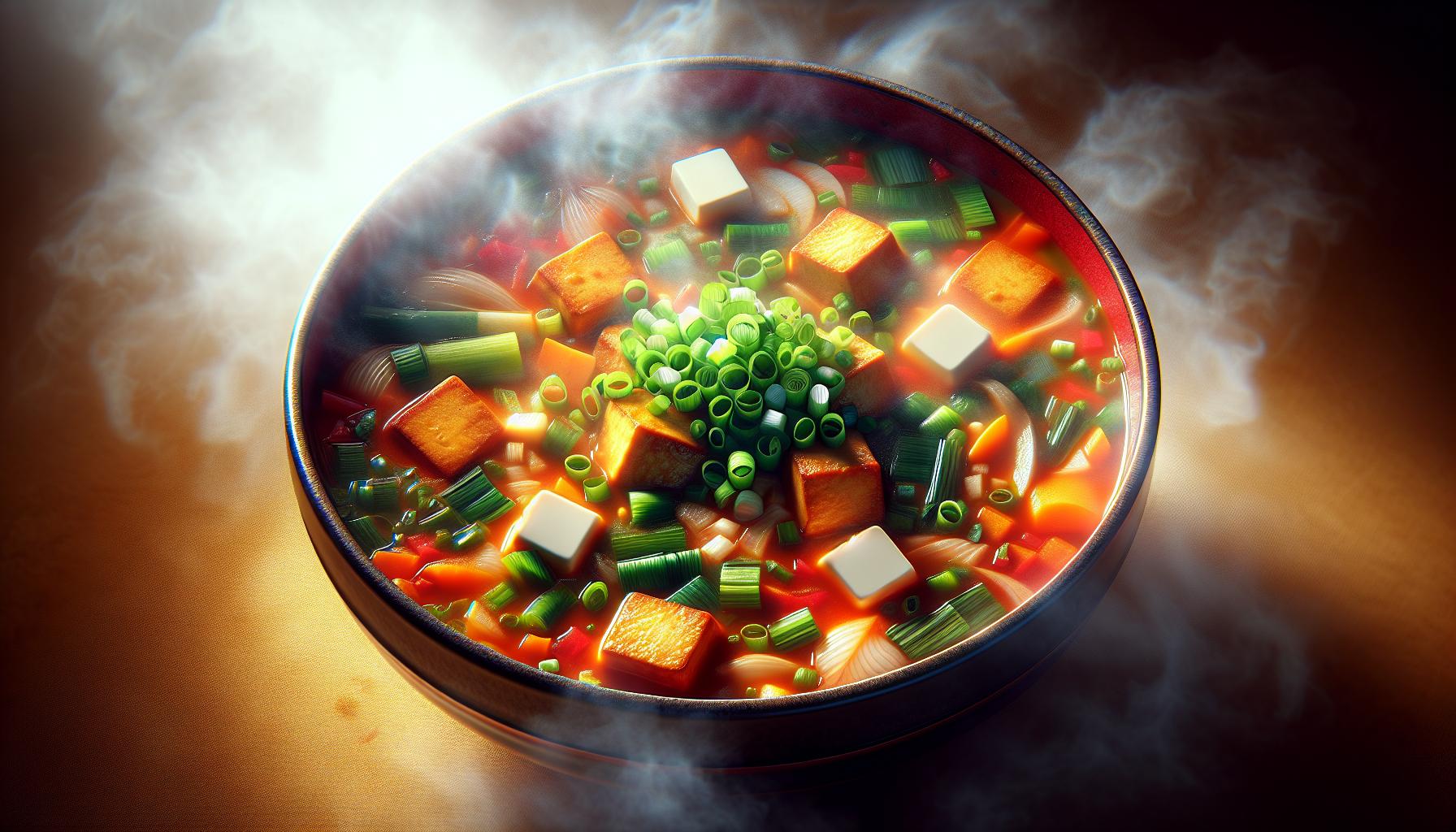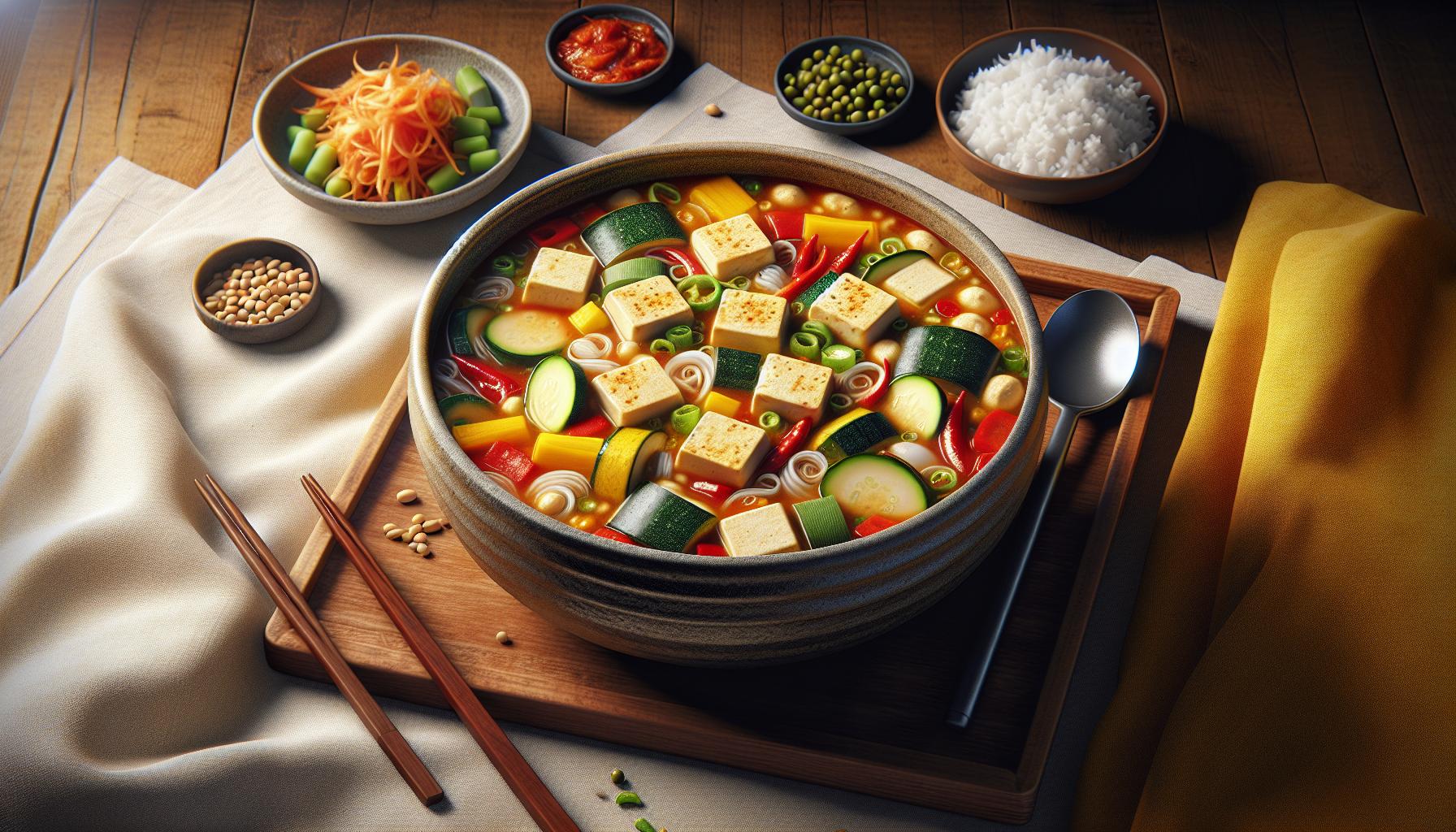History of Doenjang Jjigae
Doenjang Jjigae, a hearty Korean stew, has a lengthy and rich tale. The story begins with doenjang, a fermented soybean paste that’s been a staple in Korean households for centuries.
Doenjang’s origin traces back to the Three Kingdoms period in Korea, from 57 BCE to 668 CE. The kingdoms’ inhabitants pioneered fermentation techniques out of necessity, creating jang, Korean terms for fermented sauce.
In the 15th century, people began using soybeans as their primary source for fermentation, giving birth to doenjang. Over time, Korean households started to create and perfect their unique versions of doenjang jjigae using this versatile paste.
Bold and robust, doenjang jjigae became a popular comfort food. The dish was accessible to every class of society, enjoyed by both royalty and peasants alike. Its ingredients were simple, flexible yet flavorful. It evolved organically with the changing seasons and regional differences, resulting in myriad versions that each family uniquely claimed as their own.
Today, doenjang jjigae is more than just a dish. It’s a symbol of Korean home cooking and a mirror reflecting Korea’s history and culture. The spirit of collectivity, frugality, and resilience in Korean society are all encapsulated within a hot simmering pot of doenjang jjigae.
So as you begin your journey in making your homemade doenjang jjigae, remember every spoonful is laden with not just tantalizing flavors but also a touch of Korean heritage. You’re not just preparing food; you’re partaking in a historical Korean tradition.
Fair warning, once you dip your chopsticks in, there might be no turning back. This delicious stew might just win you over.
Ingredients You’ll Need

Roll up your sleeves, it’s time to delve into the heart of Doenjang Jjigae making: the ingredients. This hearty stew features simple, earthy components that are both nutritious and delicious.
First, you’ll need the star of the show, doenjang. For a single serving, 1/3 cup of doenjang should suffice. This fermented soybean paste is packed with rich, umami flavors that form the backbone this stew. Ensure you’re using traditional Korean doenjang, which enhances the dish’s authentic flavor.
Next, vegetables bring color, texture and nutrients into the mix. Your doenjang jjigae needs half of a medium zucchini, 1/4 of a medium onion, and two shiitake mushrooms. Chop them into bite-sized pieces for optimal taste and texture.
You’ll also throw in 1/3 block of tofu. This protein-rich ingredient enhances the stew’s body and gives it a creamier texture. If tofu isn’t your cup of tea, substitute it with pieces of fresh fish or shellfish like shrimp or clams.
Don’t forget about 1 green chili and 1 red chili. These serve for both color and spice. It’s your call whether you want to dial up the heat or keep it mild. With the chilies, we’re also adding a common seafood ingredient, 2 small anchovies, providing a deep sea flavor that pairs well with doenjang.
As a final touch, garnish your stew with 1 green onion. Not only does it add a punch of color, it also offers a slight crunch and a delicate onion flavor.
To add depth to your jjigae, feel free to play around with additional ingredients. Choices such as garlic, radish, and beef often find their way into traditional Korean kitchens. There’s no definitive recipe for Doenjang Jjigae, your version can be as bold or as demure as your taste buds dictate.
Remember, the best cooks tweak and adjust their recipes. Don’t feel shackled by the ingredients listed. Cooking is an art, and every artist has their unique touch.
| Ingredient | Quantity |
|---|---|
| Doenjang | 1/3 cup |
| Zucchini | 1/2 |
| Onion | 1/4 |
Step-by-Step Instructions

Ready to immerse yourself in the authentic flavors of Korea? Let’s dive into this simple, yet flavorful Doenjang Jjigae recipe.
First off, fill a pot with four cups of water. Add ten dried anchovies and let it simmer for 15 minutes to make the base broth.
While the broth is simmering, coarsely chop your veggies. Include half an onion, one zucchini, and two shiitake mushrooms.
Once the broth is ready, remove the anchovies and add two tablespoons of the star ingredient – doenjang. This potent soybean paste is the soul of Doenjang Jjigae. For a richer, more nuanced flavor, add a tablespoon of gochujang, red chili paste. But, if you’re not one for heat, you can skip this.
Let the broth simmer for five minutes. Stir occasionally. You want the paste to dissolve completely.
Now it’s veggie time. Toss in the onion, zucchini, and mushrooms. Let it all simmer together. Now, for some heat, slice up a couple of green and red chillies and toss them in the mix.
While your stew is simmering, cube some tofu. Tofu is a great protein source and makes the stew satisfyingly hefty. If you are a seafood lover, feel free to swap the tofu for prawns, clams, or mussels.
After the veggies are cooked, add the tofu or seafood to the pot. Let it simmer until cooked. Lastly, top it off with some chopped green onions for a burst of color and freshness.
And voila! Your doenjang jjigae is ready to bowl up, ready to be enjoyed hot and comforting. Now, wasn’t that easy?
| Ingredient | Quantity |
|---|---|
| Water | 4 cups |
| Dried Anchovies | 10 |
| Onion | 0.5 |
| Zucchini | 1 |
| Shiitake Mushrooms | 2 |
| Doenjang | 2 tablespoons |
| Gochujang | 1 tablespoon |
| Green and Red Chillies | 2 each |
| Tofu or Seafood | To preference |
| Green Onions | To garnish |
Tips for Making the Best Doenjang Jjigae

When crafting your own Doenjang Jjigae, there are a few tips that can elevate your stew to the next level. Here’s what you need to know.
Quality of Ingredients
Remember, the ingredients you use directly affect the taste and texture of your stew. Choose high-quality doenjang for a richer, deeper flavor. Fresh vegetables make a difference too. They not only add luscious colors to your stew but also ensure a hearty and nutrient-rich broth.
Experimenting with Proteins
Typically, tofu is the protein of choice in traditional Doenjang Jjigae. Yet to make your stew distinct and even more nutritious, you can try using other proteins. Options like chicken, beef or shrimp are wonderful substitutions. They each give a unique touch, without straying too far from tradition.
Adjusting Spiciness
If you crave that traditional Korean spiciness in your stew, gochujang is your answer. Adjust the amount of gochujang depending on your taste. You can add more for an intense kick or use less for a subtle hint of heat.
Health Quotient
Doenjang Jjigae isn’t only flavorful and comforting, it’s also packed with an array of nutrients. Here’s a succinct overview of the nutritional value per serving:
| Calories | Carbs | Protein | Fat |
|---|---|---|---|
| 200 | 24g | 11g | 6g |
The stew boasts vitamins from the fresh vegetables, while tofu offers a good source of protein. It’s indeed a meal that offers a tasty mix of health benefits and flavors.
Health Benefits of Homemade Doenjang Jjigae

It’s no secret that Homemade Doenjang Jjigae packs a flavorful punch, but its health benefits might surprise you. This traditional Korean soybean paste stew not only satiates your taste buds but also contributes to your overall wellness.
Let’s delve into the nutritional profile of this delectable dish. With fresh ingredients like tofu, vegetables, and high-quality proteins, Doenjang Jjigae provides a wholesome and balanced meal.
Table: Nutritional Composition
| Nutritional Component | Quantity per Serving |
|---|---|
| Calories | 250 cal |
| Protein | 12 g |
| Carbs | 20 g |
| Fat | 9 g |
| Vitamins | Rich in Vitamins A, C, E |
Protein Source Variety:
Don’t feel restricted to using tofu as your key protein source. Expanding your protein choices in Doenjang Jjigae to encompass chicken or beef can add a different dimension to the dish and increase its nutritional diversity. Different proteins bring in various micronutrients essential for your health.
Spice Level Adjustments:
Onto the spice level. Gochujang, a Korean red chili paste, gives Doenjang Jjigae its characteristic heat. But this is not just for flavor. Capsaicin, the active component in spicy peppers, has anti-inflammatory and antioxidant properties. However, you have the power to adjust the spice levels adhering to your taste and tolerance.
Digestive Health:
Lastly, let’s not forget the star ingredient, Doenjang. This fermented soybean paste isn’t just a flavor powerhouse. It’s packed with probiotics that contribute to a healthy gut. A happy gut flora equates to improved digestion and a stronger immune system.
So, there you have it, a sneak peek into the health benefits of Homemade Doenjang Jjigae. Implementing this dish into your menu not only brings diversity to your meals but also encourages healthy eating without compromising on flavor.
Conclusion
So there you have it! You’re now equipped with the know-how to whip up a flavorful, nutritious batch of homemade Doenjang Jjigae. Remember, it’s all about quality ingredients and personalizing the dish to your taste. Don’t shy away from mixing up the proteins or adjusting the spice level to your liking. This Korean soybean paste stew is more than just a delicious meal. It’s a testament to balanced nutrition, offering a variety of proteins, fresh veggies, and probiotics. It’s a dish that truly marries taste and health, proving that a wholesome meal doesn’t have to be a flavorless one. So, go ahead and give this recipe a try. Your taste buds, and your health, will thank you!

